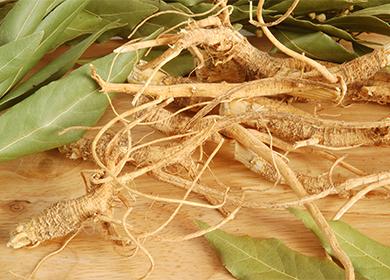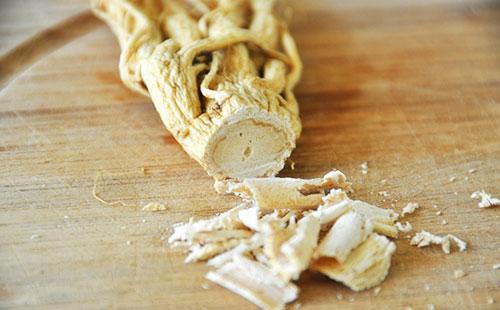The content of the article
The beneficial properties and contraindications of ginseng have not been formulated accurately to date, despite the fact that the plant has been used in medicine since ancient times. Over the past fifty years, several significant studies of its composition have been carried out, which allowed us to systematize data from unofficial sources. And to reveal why the “golden root” is really useful.
Ginseng Features
In the Middle Ages, a plant was valued in China more than gold. It was believed that it can heal from all diseases and turn the decrepit old people into young fellows. For four thousand years in the places of natural growth of culture there was a real hunt for the "golden root". Interest in him was actively fueled by traditional healers, offering many funds from a powder of precious culture from various ailments.
The reason for such a high interest in ginseng is the appearance of the rhizome and its effect on the human body. Outwardly, the root resembles a human figure, which is why it attributed magical properties. The generic name panax ginseng refers to the Greek term panakes, which means "panacea", the ability to heal.
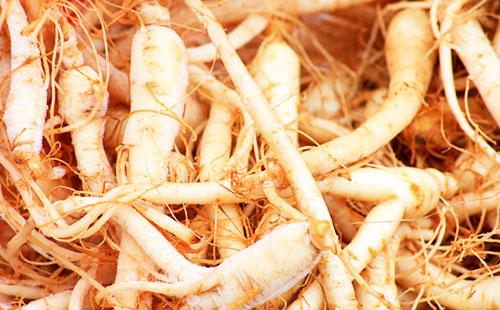
Description
The plant belongs to endangered species and is almost universally listed in the Red Book. In the natural environment, it can exist up to two hundred years, but such centenarians do not occur in nature. Usually the culture remains a compact small bush crowning a short vertical rhizome. A pale yellow juicy root in the form of a hard rod departs from it.
The root grows vertically, but bends as it approaches the surface of the earth. The stem grows to it at an angle of up to 45 degrees. Stem height - not more than seventy centimeters. It is thin, straight, usually carries four to five sheets of elliptical shape, with a serrated edge and a pointed tip. Outwardly, the leaves resemble horse chestnut, planted on purple-red petioles.
Culture is developing extremely slowly. Only in the third year of life does an arrow appear on the stem, which in July is covered with small, nondescript green flowers. By August, “fruits” are formed from them: bright red drupes that attract birds in color. The birds eat seeds, which contributes to the spread of culture. Thanks to birds in the wild, there are "ginseng families" - small groups of shrubs that usually grow apart.
The plant development cycle is long. And the seeds are so "capricious" that, even when they are in the soil, they do not necessarily sprout. The seed must be left in a suitable environment for up to twenty-two months for the embryo or kidney to develop in it. If at this time an animal steps on the seed or it is “touched” in another way, it is highly likely that it will not germinate. A "germ" can lie in the ground for up to ten years, staying in a "hibernation" until it develops into a green bush.
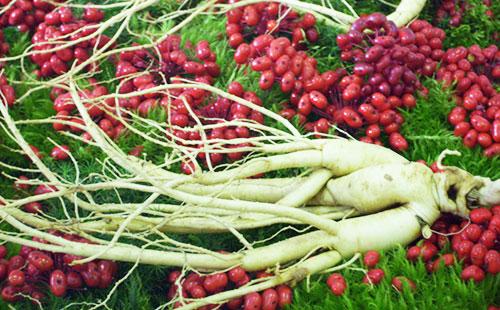
Geography and distribution
Ginseng is not one, but a whole group of plants whose habitats are scattered around the globe. American ginseng is growing in North America - the only species not found on the Eurasian continent.The largest natural populations are recorded in China in Yuannan, but Chinese ginseng is on the verge of extinction.
The first to start the artificial cultivation of a valuable crop was South Korea, which over time became the world's leading exporter of medicinal raw materials. In the Soviet Union, a specialized state farm was founded in the Primorsky Territory, which has been operating to date. On the territory of the state farm, Siberian ginseng is planted - an analogue of a plant that grows in extremely small volumes in the natural environment.
Trial bookmarks of crop plantations in the Caucasus were carried out, Russian scientists proposed an effective practice of growing ginseng under the canopy of beech forests. Private farms operate in the Moscow region and in the southern regions of Russia.
The natural distribution area in the Primorsky Territory is broad-leaved forests in the foothill areas, including cedar and fir populations. Very rarely, the plant settles within the spruce, oak and hornbeam forests. Individual bushes can be found on the eastern and western slopes of the hills.
The technology of culture of isolated tissues shortens the period of development of the root of the culture. It grows and gains the required volume much faster than a regular root. But the content of valuable elements may differ from the “original”. A number of researchers agree that the artificial “golden root” is in many ways inferior to that grown in natural conditions.
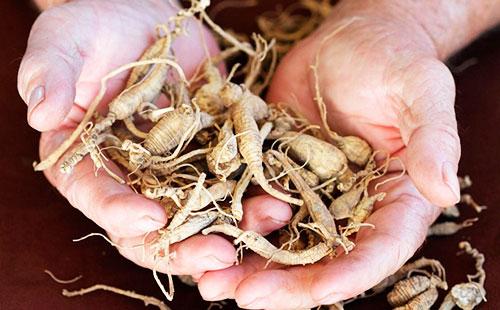
Cultivation
The high cost of raw materials, the dubious quality of the roots brought in from abroad, prompted herbal gardeners to grow valuable crops on their own. The question of how to grow ginseng in a personal plot is specific.
- The plant is extremely demanding on the soil. It should be fertile, with a constant level of humidity and temperature. Excessive waterlogging and even short-term drying of the soil delay the development of bushes for a long time.
- Seeds must be prepared. Planting is carried out by seeds that have passed two cycles of stratification. The first cycle of warm stratification requires mixing the seeds with sand in a proportion of one to three. The resulting mixture is moistened and left in a warm place (at a temperature of fifteen to twenty degrees) for four months. The recommended period of warm stratification is October-January. At this time, it is important to monitor the moisture of the mixture and periodically add water. In February, a cycle of cold stratification begins. A mixture of seeds and sand is transferred to a refrigerator, where it is kept until May. During this time, an embryo develops in the seeds, which breaks the membrane.
- Preplant disinfection. Before planting in the soil, ginseng seeds must be sanitized. Use a weak 0.5 percent solution of potassium permanganate, in which the seedlings can withstand fifteen minutes.
- Sowing in warm soil. The temperature of the soil before planting should be at least fifteen degrees, so often raised beds are organized for the plant. They warm up faster, and in May you can plant seeds. After about twenty-five days, the first sprouts appear, which develop extremely slowly. By winter, two to three leaves form on the bushes. The culture is thermophilic and needs protection in the winter. In the first year, it is imperative to cover plantings with breathable, heat-holding material: spanbond, spruce branches.
- Sowing on permanent beds. In the second year, plants can be transplanted to areas of constant growth. The beds form from west to east, pouring soil up to thirty-five centimeters high.Bushes are planted every twenty centimeters, and the distance between adjacent beds should not be less than a meter. The soil for planting is enriched with valuable components: leaf humus, compost, mineral fertilizers are used, for example, superphosphate in the amount of about forty grams per square meter. During planting, the plant is placed obliquely, and the upper bud is covered with soil.
- Shading of beds. Despite the fact that ginseng loves heat, it does not tolerate the open sun, so the beds are necessarily obscured by light plywood shields. They are installed on specially prepared posts obliquely. It is important that every half meter in the shields there are thin openings. This will allow air to circulate freely in the area of the beds, eliminating their overheating or hypothermia. Every autumn, the shields are removed, in the spring put up again.
- Protection against fungal infections. Young bushes are susceptible to fungal diseases, so they are regularly treated with copper chloride or potassium permanganate.
Ginseng root gains valuable properties after seven to eight years of plant development. Having removed the culture from the soil, rest should be given to the soil. Ginseng cultivation catastrophically depletes the soil. The recovery period is at least ten years.
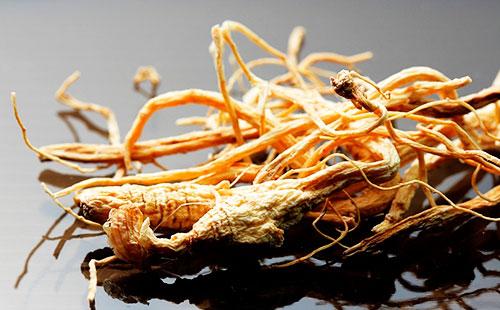
Collection and Harvesting
In a natural habitat, arbitrary collection of a medicinal plant is prohibited. Procurement is carried out under licenses in strictly defined areas with established limits. It is important that the collector has sufficient experience working with ginseng. The fact is that the roots of plants with an age of less than twenty-five years have a commodity value. The collection of early, young cultures only destroys the natural foci of growth, but has no practical value.
Dig out rhizomes weighing from ten grams. They are cleaned of the earth, not washed and quickly sent for processing. Such roots are called white. Without proper treatment, they deteriorate very quickly.
When harvesting on organized plantations, they focus on five to eight year old crops. Root collection and processing takes place on the territory of one state farm, as raw materials must be processed quickly. The roots are treated thermally: they heat the water to eighty degrees and hold them above the steam for one hour.
After that, they are laid out in one layer on newspapers and dried in the shade until the raw materials become hard. Readiness comes within one to two months. You can distinguish the finished ginseng root by color. It takes on a light brown tint. Finished raw materials are called red ginseng root, used for the production of medicines or in pure form.
At home, such technological manipulations are difficult to do. Therefore, fresh rhizome is boiled in sugar syrup for one hour over low heat. After that they take it out and dry it in air.

Composition and properties
The healing plant contains saponins - a set of seven panaxosides, similar in structure to tripertens. Some of them are derivatives of oleanolic acid, others are derivatives of protopanaxadiol. The composition also revealed substances of the pectin group, vitamins B1, B2, C. The presence of a small content of essential oil gives the rhizome a peculiar aroma.
The combination of panaxosides has a tonic, restorative effect on the body. Substances do not stimulate the activity of any one system, but provide a complex effect.
- Natural adaptogen. Panaxosides increase the body's resistance to external stress factors. Such may be unusual environmental conditions for a person, an unfavorable environment. Acceptance of ginseng root extract helps to adapt to negative factors, eliminating body stress and associated overwork, decreased immunity, and a tendency to viral diseases.
- Immunomodulator A medicinal plant changes the specific response of the immune system to external stimuli. An increase in the blood of people taking tablets or granules of ginseng, the level of protein and gammaglobulins was revealed. There is an increase in the intensity of the hematopoietic system, the synthesis of nucleic acids is approximately doubled, the rate of production of proteins by the bone marrow increases, and the activity of bone marrow cells increases. This leads to increased immunity and resistance to infection.
- Radiation protection. The medicinal plant ginseng increases the body's resistance to radiation and reduces its negative impact. Radioprotective effect is manifested with direct exposure and after it, since glycosides contribute to the removal of radioactive elements from tissues.
- Increased sexual excitability. In eastern culture, the plant is traditionally used to treat sexual impotence. Modern research confirms the logic of this therapy. Ginseng substances reduce the absorption of polysaccharides from food, while stimulating the synthesis of glycogen and phosphates - the main energy suppliers in the body. This leads to a general increase in the tone of the body, its excitability, enhances the intensity of the endocrine system in general and the reproductive system in particular.
- Increasing labor productivity. Taking ginseng drugs is considered useful for people engaged in mental work. In small doses, they activate the movement of blood through the vessels, improve breathing, excite the nervous system, which improves the well-being of a tired person. In people engaged in mental work, there is an increase in working capacity and an improvement in memory. Taking large doses of tincture of the plant leads to the opposite, sedative effect.
- Decrease in sugar level. Recently, the ability of Golden Root preparations to lower blood sugar levels has been identified. Studies are being conducted on the possibility of using drugs in the treatment of type 2 diabetes and the normalization of the condition of people with type 1 diabetes with the prospect of refusing to take insulin. The medicinal properties of ginseng are similar to synthetic insulin: it increases the intensity of glucose processing with the release of glycogens, not only lowers the sugar level, but leads to its normal values. It activates the liver: it produces more lipids that accumulate in fatty tissues.
Ginseng affects blood pressure: with hypotension it rises to a normal level, but does not have an effect with hypertension. An increase in the contractile activity of the heart and a decrease in blood cholesterol were noted.
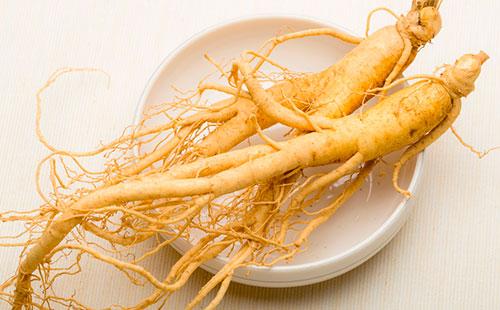
Ginseng application
In 2009, under the leadership of the candidate of biological sciences Tatyana Sovetkina, a study was conducted of the effect of ginseng preparations on the body of people living in difficult environmental conditions. The experiment at the Far Eastern Central Clinical Hospital was attended by eighteen volunteers - employees of a medical institution.
The age of the subjects is from twenty-five to fifty-five years. All of them worked in adverse hospital conditions with a high level of purulent, infected microflora. It is proved that prolonged stay of people in such conditions reduces the body's immune response, increases susceptibility to diseases of a viral and inflammatory nature.
The subjects were offered water-alcohol tincture of ginseng, which was taken orally twice a day for one month. Reception was carried out half an hour before meals, the volume of the drug for women and for men was similar - three milliliters per day. The courses were repeated three times during the year, in parallel, the blood counts were monitored.
During the experiment, there were no facts of deterioration in the well-being of the subjects. The proposed dose was well tolerated by each participant in the experiment.At the same time, there was a decrease in fatigue, an increase in tone and performance, an increase in activity and an improvement in overall well-being.
None of the participants in the experiment fell ill with a viral disease during the trial period. In people with an inflammatory disease, the severity of its course has decreased markedly. An increase in pressure was not recorded, but with hypotension, blood pressure indicators were leveled to normal.
In blood counts, there was a slight increase in the number of hemoglobin and red blood cells, the stability of protein metabolism in the liver, despite working in adverse conditions. The level of cholesterol decreased, the intensity of metabolic processes increased.
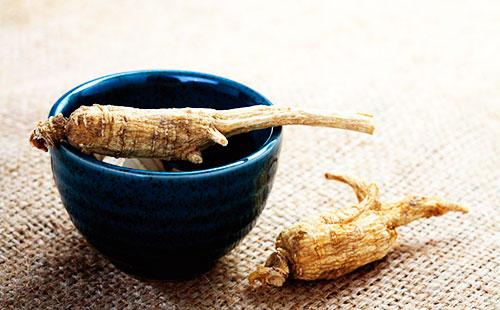
Alcohol tincture
An affordable pharmacy form of a medicinal plant. They make it on alcohol in which ginseng root is insisted. It is recommended to take with all forms of physical and mental exhaustion, with active labor, fatigue, hypotension. According to reviews, taking ginseng tincture quickly normalizes the condition, reduces the tendency to seasonal diseases.
Take tincture should be 10 drops for children and 15 drops for adults before meals twice a day. The course of treatment is carried out for a month, up to forty days. Then you need to take a break for two weeks and, if necessary, repeat the course. With severe asthenia, an improvement in well-being is observed after the second, third course. With fatigue, fatigue occurs during the first course.
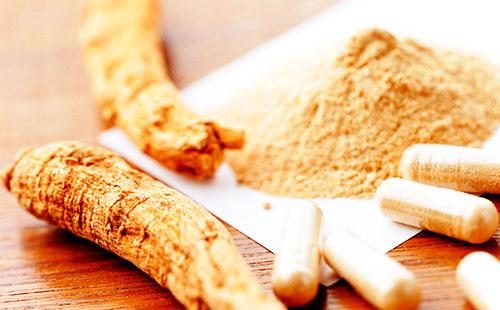
Powder
Powdered from grated ginseng root can be taken in pure form or in the form of tea. In its pure form, the dosage is 0.15 grams twice-thrice a day before meals.
Tea is brewed in a proportion of one part powder to ten parts boiling water. Insist and use one tablespoon twice a day.
Decoction
Used as a general tonic, as well as to increase the body's resistance to colds. The broth is more convenient and faster to prepare than alcohol tincture. And contains a large concentration of active substances.
- Grind one root.
- Place in an enamel container.
- Pour in five hundred milliliters of hot water.
- Bring to a boil and simmer over low heat until the volume of liquid is reduced by half.
Take the broth twice a day in a tablespoon before meals.
Butter
One of the cosmetic forms of the medicinal plant is ginseng oil, the use of which is considered as a rejuvenating agent. The drug is made on the basis of olive oil, which is heated and insisted in it crushed rhizome.
It is important to understand that oil is a cosmetic product. It can be used for hair and skin care. In the first case, it is applied warm to the roots one hour before bathing, rubbed well into the scalp. In the second, a few drops are added to the cream or lotion in order to enrich their composition.
But taking the dosage form of ginseng inside and its external use are completely different techniques. The oil does not have a tonic effect, and in skin care does not show a rejuvenating effect.
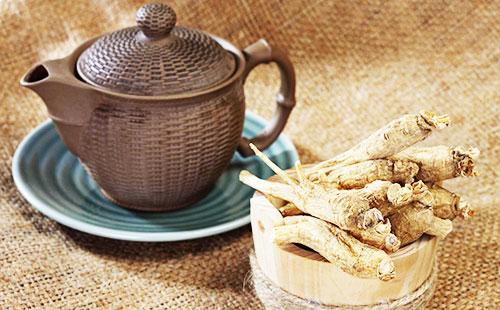
Contraindications
The medicinal plant has practically no contraindications. It can be taken by children and the elderly to increase body tone, stimulate vitality, immunity. It is only important to observe the dosage and limit the intake to the recommended course.
With prolonged use and increasing dosage, the opposite effect is observed. The drugs have a sedative effect, can cause headaches and palpitations.
Ginseng is contraindicated in pregnancy and lactation, since there have been no studies of its effects on the body of the expectant mother and infant.
Ginseng is considered a cure for all diseases, but in reality, a valuable plant does not cure anything. It serves as a stimulator of strength and energy, improves well-being, helps maintain a high level of performance, endurance, mental activity in stressful situations. Increases immunity and normalizes sexual function, but does not have a hormonal effect. Take the product should be in the form of a decoction or alcohol tincture.
